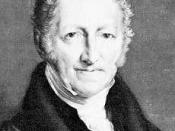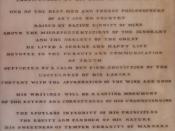1. Explain and evaluate critically Malthus's population theory.
In 1798 Thomas Robert Malthus, a British clergyman and professor, wrote an essay showing the way to modern demography. In 1824 he wrote a shorter final version, the article on population for that year's Encyclopedia Britannica. Malthus has been criticized for his lack of scientific foresight--he did not foresee modern advances leading to increased life expectancy, food production and birth control. He has been criticized for his politics--he thought welfare immorally increased population and hunger. He has been criticized for pessimism--the adjective Malthusian is associated with a gloomy outlook for humanity. But he showed the way for the study of human population.
People. To learn how fast people might reproduce, Malthus examined the United States census. Conveniently, that count was required each decade, starting in 1790, by the Constitution of the former British colonies. Land was so fertile and uncrowded that food production seemed not to limit population growth.
Immigration counts were available to subtract from natural rates of population growth, thus revealing net reproductive growth. Malthus observed that under such ideal conditions, during each 25 years the human population tends to double. So if world population is represented by 1, then after each 25 years it would be 2, 4, 8, 16, 32 and so on, provided there were no limits on such 'natural' rates of population increase.
Food. To learn how fast people might produce food, Malthus examined agriculture in several countries, and made a rough estimate: all food produced could increase each 25 years by at most the prior 25 years' increase. So if food production is represented by 1, then after each 25 years it would be 2, 3, 4, 5, 6, and so on. In other words, food could only increase arithmetically, whereas the population if...


